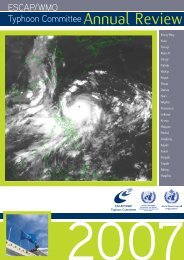TCAR - Typhoon Committee
TCAR - Typhoon Committee
TCAR - Typhoon Committee
You also want an ePaper? Increase the reach of your titles
YUMPU automatically turns print PDFs into web optimized ePapers that Google loves.
forecast on 64 bits LINUX parallel system with<br />
the initial and boundary condition of GFS model<br />
and NCEP center. The minimum temperature<br />
of the model showed good agreement with the<br />
observed data, especially at the stations located<br />
at long distance away from coastal areas such as<br />
Chiang Mai and Ubon Ratchathani<br />
· Climate variability during pre-southeast<br />
monsoon<br />
The study of climate variability in Thailand during<br />
the pre-southwest monsoon using the record<br />
data of 45 stations from 1951-2008 to statically<br />
analyze its variability. The results showed that<br />
the pattern of rainfall in all parts of Thailand is<br />
increasing, except in the southwest part where<br />
it showed decreasing in its tendency, while both<br />
the maximum and minimum temperature showed<br />
significantly increase in all parts of the country.<br />
ENSO, IOD and MJO are also investigated<br />
to explain the relations to rainfall in the presouthwest<br />
monsoon of Thailand<br />
· Suitable Monsoon Indices Investigation<br />
for Thailand<br />
Thailand monsoon indices are calculated from<br />
the differences of the 850 hPa U-wind of the<br />
selected area. The areas selected for indices<br />
investigation are 40-80 0 E, 5-15 0 N, and 90-110<br />
0 E, 20-30 0 N referred as TMI1, and 80-100 0 E,<br />
5-15 0 N and 90-1100 0 E, 20-30 0 N referred as<br />
TMI2. The results showed that indices from TMI2<br />
played more significant role ,with R 2 at 0.5-0.8,<br />
on monthly average rainfall change than those of<br />
TMI1 where R 2 at 0.4-0.6 , particularly in upper<br />
Thailand.<br />
Training: In 2009, TMD received WMO/ TCTF/<br />
TCS support to attend the training courses in<br />
the TC as follows:<br />
Table 4.<br />
<strong>TCAR</strong><br />
CHAPTER 1 - TYPHOON COMMITTEE ACTIVITIES<br />
2009<br />
No. Course Title (s) Duration Country No. of<br />
participant(s)<br />
1. The 1st Training<br />
and Research<br />
Coordination<br />
Group (TRCG)<br />
Technical Forum<br />
2. Training on<br />
Hydrological<br />
Observation and<br />
Flood Forecasting<br />
Method and<br />
System<br />
3. The 3rd On-thejob<br />
Training of<br />
Flood Forecasting<br />
System Based on<br />
the Tank Model<br />
(OJT)<br />
4. The Integrated<br />
Workshop<br />
on Building<br />
Sustainability<br />
and Resilience in<br />
High Risk Areas<br />
of the <strong>Typhoon</strong><br />
<strong>Committee</strong>:<br />
Assessment and<br />
Action<br />
5. <strong>Typhoon</strong> roving<br />
seminar<br />
6. The Second<br />
WMO<br />
International<br />
Workshop on<br />
tropical cyclone<br />
landfall process<br />
Sensing an<br />
12 - 15 May<br />
2009<br />
20 - 26 July<br />
2009<br />
21 July -<br />
23 August<br />
2009<br />
14 - 18<br />
September<br />
2009<br />
16-19<br />
November<br />
2009<br />
19-23<br />
October<br />
2009<br />
Republic of<br />
Korea<br />
3<br />
China 4<br />
Malaysia 1<br />
Philippines 3 (TMD),<br />
1 (RID),<br />
2 (DDPM)<br />
China 2<br />
China 1<br />
e. Regional Cooperation Achievements/<br />
Results<br />
Please refer to Regional Cooperation Assessment<br />
f. Identified Opportunities/Challenges for<br />
Future Achievements/<br />
Results<br />
· Participation in the TIPs workshop at Jeiju,<br />
131

















